In vitro fertilisation or IVF is one of the most popular ways for couples with infertility issues to have babies. A common Assisted Reproductive Technology (ART), IVF treatment eliminates the need for relying on the natural fertilisation of eggs. Instead, eggs and sperm are handled outside the body and united in a petri dish in a lab- controlled environment to develop embryo(s). This embryo(s) is then transferred to the female partner’s uterus. Once the embryo implants in the uterus wall, pregnancy is established.
Although it sounds quite simple theoretically, many couples worry about the practicality of the treatment. One of the most common questions asked by couples pursuing IVF treatment is—is IVF painful? This question mainly arises because the eggs are extracted from the ovaries, fertilised in a lab setting, and then embryo(s) are transferred to the uterus for implantation. None of these processes demands major surgery or a long recovery period. If executed by experienced fertility doctors, these procedures are quite simple, painless, and risk-free. Here’s all you need to know about the steps involved in the IVF treatment and what happens during each stage:
Step 1: Hormone injections
The female partner is put on a course of medication and injections for follicular growth and ovulation. You must go through many rounds of follicle-stimulating hormone (FSH) and luteinizing hormone (LH) injections until the eggs are mature and ready for retrieval. A day before the egg retrieval process, you will be given a shot of the human chorionic gonadotropin (hCG) hormone for prompt egg release. These injections prompt your ovaries to mature several eggs instead of just one. This process is also known as ovarian stimulation.
During this phase, you may experience some discomfort and side effects such as bloating, tender breasts, and insomnia due to hormone injections. Also, you may experience temporary pain at the injection site.
Step 2: Egg retrieval
In preparation for egg retrieval, your doctor will track the growth of your eggs by periodically performing a transvaginal ultrasound. Once you have enough mature eggs for retrieval, your doctor will schedule the egg pick-up procedure, also known as follicular aspiration. It is a day procedure and is usually performed under general anaesthesia. In this process, your doctor will extract mature eggs from your ovaries using an ultrasound-guided thin needle which will be inserted through the vagina.
While you will not feel anything, including pain, during the process, you may experience slight cramping and discomfort afterwards. This discomfort usually gets better within a day. Some women may experience mild vaginal bleeding after the egg retrieval process. Do not worry about it. Just give your body some rest and you will be okay in a day or two. However, if you experience severe discomfort or pain, reach out to your doctor for pain relief medication. The mild painkillers prescribed by your doctor should do a good job of keeping you comfortable.
Step 3: Sperm collection
This is the simplest of the IVF treatment processes. The male partner will be asked to givea sperm sample to the fertility clinic’s lab. Usually, the sample is collected through masturbation—easy, simple, and painless.
In cases where the male partner has fertility issues such as Azoospermia—a condition where a man’s ejaculate lacks sperm—your doctor may recommend Testicular Sperm Aspiration. Also known as TESA, it is a surgical procedure involving the use of a thin needle to extract sperm directly from the testicle.TESA is performed under mild anaesthesia, which means you will not feel any pain during the process. However, you may experience some discomfort afterwards which will get better in a day. It is a day procedure and does not require hospitalisation.
Step 4: Fertilisation
Once the sperm sample is collected, it is put through a high-speed wash and spin cycle to separate healthy sperm from the semen fluid. Meanwhile, the extracted eggs are made ready for fertilisation. Then, the eggs and sperm are left in a petri dish for fertilisation. It takes some time for sperm to fertilise the egg. Then the fertilised eggs are moved to the embryo incubator to promote further growth until they are ready for transfer.
In some cases, where the sperm has motility or structural issues that stop it from entering the egg for fertilisation, experts may perform intracytoplasmic sperm injection or ICSI. In this process, a single healthy sperm is directly injected into a mature egg for fertilisation.
All this happens in a controlled lab setting.
Step 5: Embryo transfer
This is the most crucial step of IVF treatment. The fertilised embryo is transferred to the female partner’s uterus for implantation. For this, the doctor inserts a long, thin, flexible tube, called a catheter, into your vagina. This tube is made to pass through the cervix, into the uterus. The embryo(s) is transferred using a syringe which is inserted via the catheter. So, you do not feel the needle directly. The embryos are left in the uterus for implantation.
It is a simple day procedure and does not require sedation. While you may experience some discomfort during the process, you will be over it by the time it is completed. There is hardly again pain during or afterwards.With this step, the IVF treatment is concluded for the cycle. Now, all you have to do is wait for 14-15 days before taking a pregnancy test to know if the cycle has been successful. The two pink lines on your home pregnancy test kit will mark the beginning of your pregnancy journey.
Conclusion
So, the answer to the question—‘Is IVF painful?’—is simple. While there are parts that may feel tiring and exhausting such as following the strict injection schedule at the beginning of the treatment and phases where you feel some discomfort, the effort is worth it for what you can get in return. As far as pain is concerned, rest assured that none of the procedures is excruciatingly painful or complex. In fact, even the chances of post-operative infections are minimal.
Therefore, approach the IVF treatment with a confident and positive mindset, keeping in mind your goal of becoming a parent and it will be easier than you imagine.
Also Read: How Personal Loans are Good for the Indian Economy


































